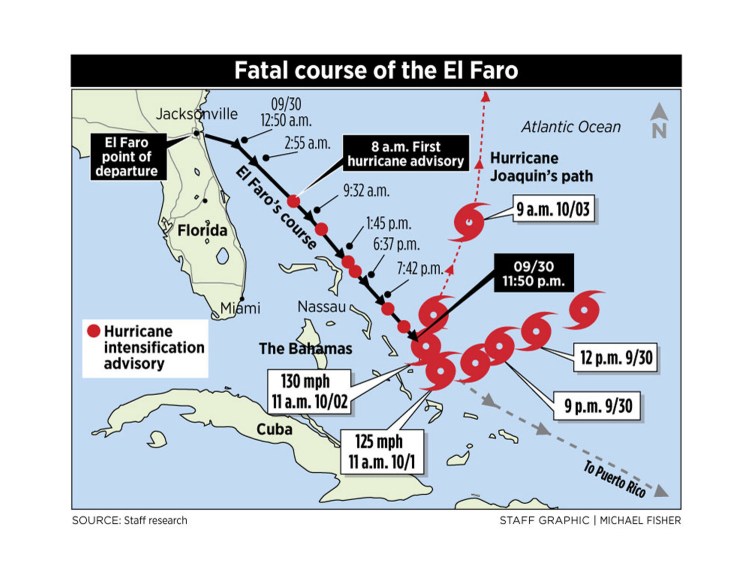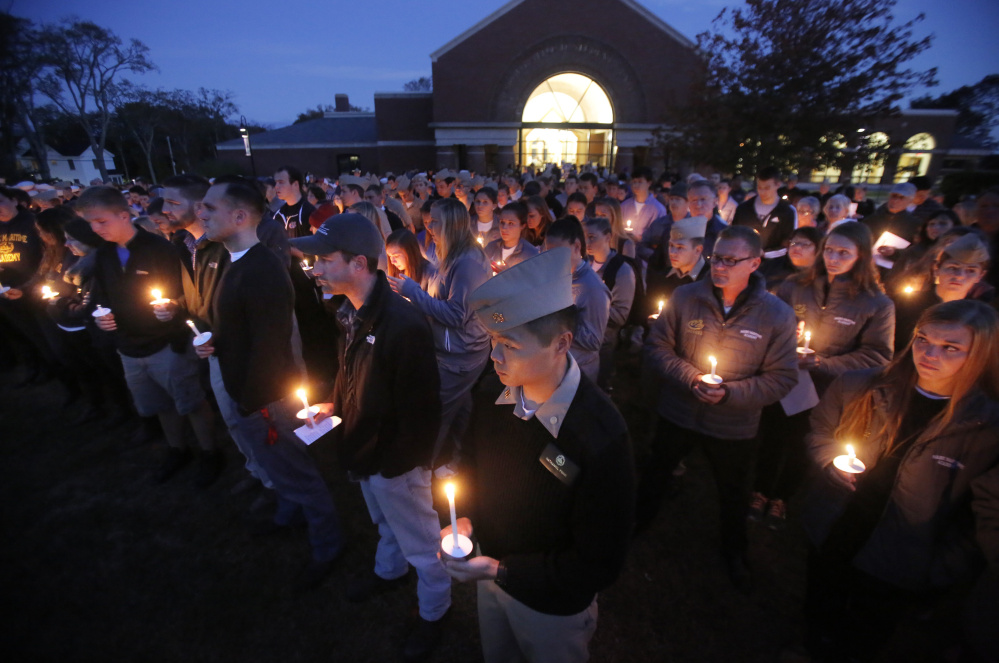The hurricane that would ultimately sink the cargo ship El Faro was still a tropical storm when the vessel left Jacksonville, Florida, the night of Sept. 29.
The ship was hundreds of miles into its 1,300-mile voyage to Puerto Rico by the time the National Weather Service upgraded Tropical Storm Joaquin to Hurricane Joaquin, packing 75 mph winds, at 8 a.m. the following day.
But ship tracking data show that the El Faro appears to have stayed its course toward the storm’s predicted path even as the weather service issued seven more hurricane advisories over the next 21 hours – each warning of the storm’s growing strength – before the ship’s last known communication near the Bahamas.
Capt. Michael Davidson’s decision to stay the course in an apparent bid to outrun the storm will likely be a key part of the investigation launched Tuesday by the National Transportation Safety Board into what appears to be the United States’ worst commercial maritime disaster in decades. But as frequently happens immediately after such disasters, debate has already begun about whether the captain or the El Faro’s owner, TOTE Maritime Puerto Rico, made fatal calls or whether the ship fell victim to that “perfect storm” of bad luck and the unpredictability of Mother Nature.
Answers to some of those questions are likely months away, if they are ever known.
“They want to document thoroughly the investigation, and it will take time,” Marjorie Murtagh Cooke, who headed the NTSB’s Office of Maritime Safety from 1994 to 2005, said of the federal investigators. “Unfortunately, everybody wants to know what happened immediately, but … it’s a long, detailed process of getting the facts that will lead to not just (NTSB) conclusions and recommendations, but also information that can help make sure something like this doesn’t happen again.”
There are plenty of known facts about the El Faro and its crew.
The 790-foot-long ship had been in service for 40 years – a long time for cargo vessels – but had been regularly maintained and updated. Davidson, of Windham, was a veteran captain with several decades of experience and a strong reputation in Maine and around the industry. At least three other Maine residents – 34-year-old Danielle Randolph of Rockland, 25-year-old Michael Holland of Wilton and 23-year-old Dylan Meklin of Rockland – were among the 28 American crew members plus five ship workers from Poland. All four Mainers were graduates of Maine Maritime Academy.
It’s also clear that Joaquin was still a manageable tropical storm when the El Faro set sail from Jacksonville, although forecasts already were warning that the storm would likely intensify. What isn’t known is exactly what went into Davidson’s decision to sail a route east of the Bahamas that would take the El Faro closer to the storm, rather than the longer but potentially safer route closer to the Florida coast.
DECIDING WHETHER TO SHIP OUT
TOTE officials said Monday that Davidson planned to bypass or essentially outrun Joaquin before the ship suffered a mechanical failure that disabled it and left it adrift in the path of the increasingly powerful storm. They also said TOTE Maritime “authorized the sailing knowing that the crew are more than equipped to handle situations such as changing weather.”
The website MarineTraffic.com, which uses data from automated location reporting equipment to track ship movements around the globe, shows that the El Faro proceeded in a fairly straight course from the Florida coastline to the Bahamas at speeds of 18 to 20 knots until the last ping was recorded just before midnight Thursday.
Although the families of Maine crew members have expressed strong support and confidence in the captain, some observers have questioned Davidson’s decision or wondered whether he was somehow pressured to stick to the quicker route.
Experts and seasoned mariners said that although captains frequently discuss their plans with ship owners, it is ultimately the captain’s call about when a trip should be made.
Bernie Marciniak, a retired captain with major global shipping lines who lives in Boston, said there is always pressure on a captain to keep to a schedule, but there also could be consequences for any captain who took a vessel into a storm that caused damages or injuries. Marciniak wondered why Davidson didn’t take another route as the storm reports grew more dire, or hole up in the Bahamas, but said there are many uncertainties about the El Faro’s situation.
“Nobody from the (main) office can ever tell you as a captain where to go because of weather or whatever. However, the pressure from the shipping office is intense,” Marciniak said.
Capt. Sam Stephenson, who teaches emergency ship handling at Resolve Maritime Academy in Florida, told the Miami Herald that Davidson “was going to cross the storm at some point” based on his route.
“In my opinion, it makes no sense to do that,” Stephenson told the paper. “When you’re a ship, you want to avoid the storm at all costs.”
SERIES OF ILL-FATED CIRCUMSTANCES?
But Capt. Harry Bolton, a veteran master aboard commercial vessels who is now commanding officer of the California State University Maritime Academy’s training ship, said there was “no way in hell” that Davidson or any other experienced captain would take a ship and its crew into harm’s way.
“No captain is going to take their ship into the eye of a storm” like Joaquin, said Bolton, who has more than 40 years of experience in maritime service. “Like most tragedies, it is likely a series of incidents that happened aboard the ship or in the environment that we often call the ‘perfect storm.’ … When you get the perfect conditions of a ship that has an engine casualty and a storm that explodes, that is a catastrophe waiting to happen.”
Bolton, who worked for TOTE in the late 1970s and actually sailed aboard the El Faro’s sister ship in the company, described TOTE as “one of the best in the United States.” He angrily dismissed any suggestions that the company would put its ship or crew at risk.
“The decision process rests with the captain, not with the company,” he said. And in the El Faro’s case, Bolton said he had no doubts that the ship would have outrun Joaquin had it not encountered engine trouble.
“If they had engines, we would not be talking right now,” Bolton said. “It would just be another thing mariners go through” and tell tales about later.
Laurence Wade, a merchant marine captain for more than 30 years and later master of the Maine Maritime Academy training ship, said he never likes to see people questioning a captain’s decision, particularly those with no experience at sea.
“Sailing in bad weather, even in hurricanes, is part of the way of life for mariners,” said Wade, 73, who is retired and lives just outside Bangor. “You do the best you can. You ride it out. If the (El Faro) hadn’t lost power, it would have been in San Juan by Friday and back in Jacksonville today.”
Similarly, Wade cautioned people not to speculate about whether the crew waited too long to abandon ship. He said in most cases, the cargo ship would be the most stable place to ride out a storm.
“It’s hard to speculate because we really don’t know what was going on out there and may not for some time,” he said, “but in general, you stay with the ship as long as you can.”
DATA RECORDER MAY HOLD ANSWERS
F. John Nicoll, a retired captain who spent years piloting the run to Puerto Rico, predicted the NTSB investigation will touch on whether the pressure to deliver the cargo on time played a role in the tragedy.
“Time and money are an important thing” in the shipping industry, Nicoll told The Associated Press. Emails or other messages between Davidson and the company could help answer that question, Nicoll said.
The NTSB investigation will delve into a lengthy list of issues, including the ship’s repair history and condition before leaving port, the experience level of the crew, maintenance records and any communications between the captain and TOTE officials.
Commercial shipping vessels are also equipped with a “voyage data recorder,” similar to the “black boxes” found on commercial aircraft, that is designed to activate if the ship sinks. The data recorder will “ping” for up to 30 days to help searchers find the lost ship. If found, the data recorder will provide investigators with information on what was happening to the ship mechanically, as well as recordings of ship-to-shore conversations and bridge conversations for 12 hours prior to activation.
Cooke, the former director of the NTSB’s Office of Maritime Safety, said that investigation will be even more complicated if the El Faro is not located. However, investigators’ first task will be to collect facts and then get agreement from the various parties – including TOTE and the U.S. Coast Guard – about those facts. Eventually, investigators will present a draft report and recommendations to the board, which will review them during a public process.
Cooke would not speculate about the case or offer opinions about the ship’s course, saying, “We don’t know what (Davidson) knew and when he knew it.
“However, in this case they lost the use of the main engine, and once you lose your main source of power at sea, you are at the mercy of the sea,” Cooke said. “You have no control of the vessel and no power to take the ship away from the path of the hurricane.”
Also on board the El Faro were five Polish workers preparing the engine room for a refit. On Tuesday, questions were raised about whether that work could have contributed to the loss of engine power. Many believe that is what ultimately doomed the ship, leaving it unnavigable in a storm with winds exceeding 120 mph and 50-foot waves.
The company did not provide details about the nature of the Polish crew’s work, but representatives said they didn’t believe there was a link.
“I don’t believe based on the work they were doing that they would have had anything to do with what affected the propulsion,” said Phil Greene, a TOTE executive, according to The Associated Press.
Send questions/comments to the editors.






Success. Please wait for the page to reload. If the page does not reload within 5 seconds, please refresh the page.
Enter your email and password to access comments.
Hi, to comment on stories you must . This profile is in addition to your subscription and website login.
Already have a commenting profile? .
Invalid username/password.
Please check your email to confirm and complete your registration.
Only subscribers are eligible to post comments. Please subscribe or login first for digital access. Here’s why.
Use the form below to reset your password. When you've submitted your account email, we will send an email with a reset code.